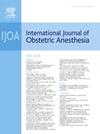虚拟现实与氧化亚氮分娩镇痛的比较:一项可行性、前瞻性、随机、交叉、非劣效性研究
IF 2.3
3区 医学
Q2 ANESTHESIOLOGY
引用次数: 0
摘要
虚拟现实(VR)平台已经成为一种非药物的分娩镇痛药。我们假设VR在缓解分娩疼痛方面的效果不逊于氧化亚氮(N2O)。主要目的是比较VR和N2O对分娩疼痛缓解满意度的效果。方法:我们进行了一项机构审查委员会批准的前瞻性、随机、交叉、非劣效性研究,将VR与N2O进行比较。主要结局是干预后30分钟对疼痛缓解的满意度(口头数值评定量表0 - 10)。次要结局是15分钟疼痛缓解满意度(0-10)、疼痛变化(0-10)、焦虑(0-10)、应对疼痛能力(0-10)、副作用发生率和治疗方式偏好。产妇接受30分钟的VR,然后30分钟的N2O,干预之间有5分钟的冲洗以减少携带。VR和N2O的顺序随机化。选择2/10的组间差异作为非劣效性裕度。结果20例患者中18例完成研究,每组9例。VR干预在疼痛缓解、疼痛改变、焦虑和应对方面的满意度不低于N2O。分别在15和30分钟的时间间隔,VR和N2O对疼痛缓解的满意度差异并不低[-0.24,90% CI(- 1.53, 1.06)和0.65,90% CI(- 0.66, 1.95)]。结论:这项初步研究的数据表明,VR是一种很有前景的非药物镇痛选择,在分娩疼痛管理方面不逊于N2O。未来需要更大规模、更有力的研究来证实这项研究的结果。本文章由计算机程序翻译,如有差异,请以英文原文为准。
Virtual reality compared to nitrous oxide for labor analgesia: A feasibility pilot, prospective, randomized, cross-over, non-inferiority study
Background
Virtual reality (VR) platforms have emerged as a non-pharmacologic labor analgesic. We hypothesized that VR would be non-inferior to nitrous oxide (N2O) for satisfaction with labor pain relief. The primary aim compared efficacy of VR to N2O for satisfaction with pain relief during labor.
Methods
We conducted a Institutional Review Board approved, prospective, randomized, crossover, non-inferiority study comparing VR to N2O. The primary outcome was satisfaction with pain relief (verbal numerical rating scale 0––10) post-intervention at 30 minutes. Secondary outcomes were satisfaction with pain relief at 15 min (0–10), change in pain (0–10), anxiety (0–10), ability to cope with pain (0–10), incidence of side effects and therapeutic modality preference. Parturients received 30 minutes of VR and then 30 min of N2O, with a 5-minute washout between interventions to reduce carryover. The order of VR and N2O was randomized. A < 2/10 difference between groups was selected as the non-inferiority margin.
Results
18 of 20 patients completed the study with 9 in each group. The VR intervention was non-inferior to N2O for satisfaction with pain relief, change in pain, anxiety, and coping. At 15- and 30-min time intervals, respectively, satisfaction with pain relief difference between VR and N2O was non-inferior [-0.24, 90 % CI (−1.53, 1.06) and 0.65, 90 % CI (−0.66, 1.95)].
Conclusion
Data from this pilot study suggest that VR is a promising non-pharmacological analgesic option that is non-inferior to N2O for labor pain management. Future larger, well-powered studies are needed to confirm the results of this study.
求助全文
通过发布文献求助,成功后即可免费获取论文全文。
去求助
来源期刊
CiteScore
4.70
自引率
7.10%
发文量
285
审稿时长
58 days
期刊介绍:
The International Journal of Obstetric Anesthesia is the only journal publishing original articles devoted exclusively to obstetric anesthesia and bringing together all three of its principal components; anesthesia care for operative delivery and the perioperative period, pain relief in labour and care of the critically ill obstetric patient.
• Original research (both clinical and laboratory), short reports and case reports will be considered.
• The journal also publishes invited review articles and debates on topical and controversial subjects in the area of obstetric anesthesia.
• Articles on related topics such as perinatal physiology and pharmacology and all subjects of importance to obstetric anaesthetists/anesthesiologists are also welcome.
The journal is peer-reviewed by international experts. Scholarship is stressed to include the focus on discovery, application of knowledge across fields, and informing the medical community. Through the peer-review process, we hope to attest to the quality of scholarships and guide the Journal to extend and transform knowledge in this important and expanding area.

 求助内容:
求助内容: 应助结果提醒方式:
应助结果提醒方式:


